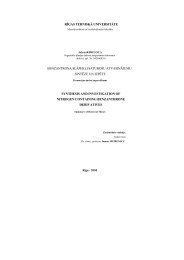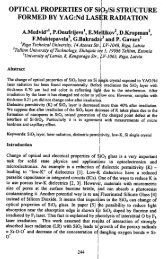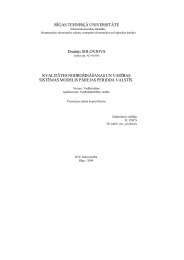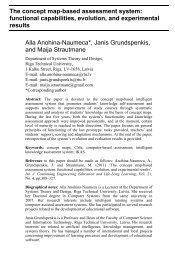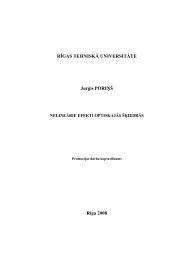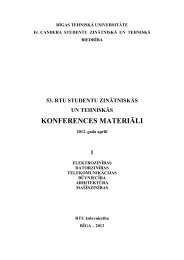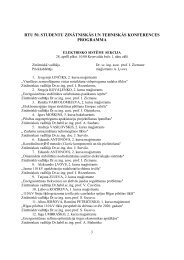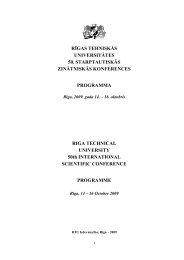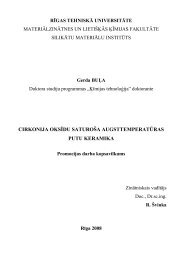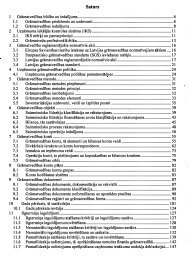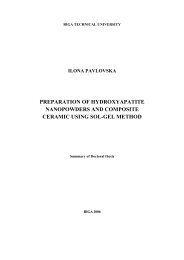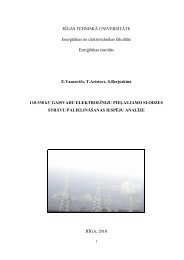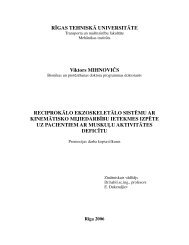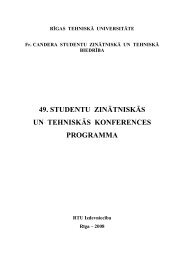Effect of different mix compositions and curing regimes ... - Aleph Files
Effect of different mix compositions and curing regimes ... - Aleph Files
Effect of different mix compositions and curing regimes ... - Aleph Files
Create successful ePaper yourself
Turn your PDF publications into a flip-book with our unique Google optimized e-Paper software.
<strong>Effect</strong> <strong>of</strong> <strong>different</strong> <strong>mix</strong> <strong>compositions</strong> <strong>and</strong> <strong>curing</strong> <strong>regimes</strong> on ultra high performance concrete<br />
compressive strength<br />
Janis Justs 1 , Genadij Shakhmenko 2 , Diana Bajare 3<br />
1 Riga Technical University , Kalku str. 1 LV-1658, Riga, Latvia. E-mail: jjusts@inbox.lv<br />
2 Riga Technical University , Kalku str. 1 LV-1658, Riga, Latvia. E-mai: gs@apollo.lv<br />
3 Riga Technical University , Kalku str. 1 LV-1658,Riga, Latvia. E-mail diana.bajare@rtu.lv<br />
Abstract. Influence <strong>of</strong> <strong>different</strong> <strong>mix</strong> <strong>compositions</strong> <strong>and</strong> <strong>curing</strong> <strong>regimes</strong> on ultra high performance concrete (UHPC)<br />
compressive strength are analysed in this paper. All produced <strong>mix</strong>es have self compacting consistency. For test<br />
purposes cubes 100x100x100 mm were produced <strong>and</strong> cured in <strong>different</strong> <strong>regimes</strong>: at 20 o C; 90 o C <strong>and</strong> 220 o C. Test<br />
results indicate that compressive strength <strong>of</strong> UHPC increased significantly after <strong>curing</strong> at 220 o C comparing to the<br />
st<strong>and</strong>art <strong>curing</strong> at 20 o C. Obtained results varied from 133–218 MPa.<br />
Keywords:.UHPC, silica fume, W/C ratio, superplasticizer, <strong>curing</strong> <strong>regimes</strong><br />
Introduction<br />
Ultra high performance concrete (UHPC), namely<br />
concrete with compressive strength starting from 150<br />
MPa, is a relatively new construction material <strong>and</strong> therefore<br />
its potential is not yet fully discovered. (Mehta et al.<br />
2005) Although there are some projects in USA, Germany<br />
<strong>and</strong> Japan where UHPC has been applied successfully,<br />
in Latvia research on this material has begun only<br />
recently. To encourage further research on qualities <strong>and</strong><br />
application <strong>of</strong> concrete, Latvian Concrete Association<br />
organizes competition on concrete samples since 2002.<br />
The target <strong>of</strong> participants is to prepare a sample achieving<br />
maximum concrete cube compressive strength. As it can<br />
be seen from figure 1, concrete, which can be described<br />
as ultra high performance concrete (compressive strength<br />
>150 MPa), was first obtained in Latvia in 2006.<br />
Some preconditions have to be considered in order<br />
to reach such strength: 1) lower water/cement ratio that<br />
for conventional concrete; 2) use <strong>of</strong> high quantity <strong>of</strong> cement;<br />
3) dense packing <strong>of</strong> particles. (Mačiulaitis et al.<br />
2009) have confirmed that physical <strong>and</strong> mechanical properties<br />
<strong>of</strong> the hardened concrete depend on the size <strong>of</strong> utilized<br />
coarse aggregate. Very fine particles are used to<br />
achieve dense packing, In this study silica fume was used<br />
as fine particles. However silica fume in concrete matrix<br />
is not only filling voids between larger particles, but also<br />
takes part in chemical reactions. It takes part in pozzolanic<br />
reaction, where Ca(OH) 2 is consumed <strong>and</strong><br />
stronger calcium hydrosilicates are produced (Grutzeck et<br />
al. 1982). Ultra high performance concrete has numerous<br />
advantages compared to conventional concrete. Due to<br />
Fig 1. Results <strong>of</strong> Latvian Concrete Association concrete<br />
competition
excellent mechanical properties, dimensions <strong>of</strong> structural<br />
members can be decreased thus allowing to reduce construction<br />
dead weight significantly. It helps to improve<br />
concrete durability by producing more dense matrix (Aitcin<br />
2003). Silica fume also improves chemical resistance<br />
<strong>of</strong> concrete (Yamato et al. 1989). Higher compressive<br />
strength can be reached by <strong>curing</strong> concrete under elevated<br />
temperatures (Urs Muller et al. 2008). Elevated temperature<br />
accelerates pozzolanic reaction. As (Ingo Scachinger<br />
et al. 2008) long term study shows, the strength development<br />
after heat treatment is not ceasing.<br />
1. Materials<br />
1.2. Aggregate<br />
Four types <strong>of</strong> aggregate were used:<br />
1. Diabaz 2–5 mm<br />
2. Diabaz 0–5 mm<br />
3. S<strong>and</strong> 0.3–2.5 mm<br />
4. S<strong>and</strong> 0–0.5 mm<br />
Granulometric curves for aggregate were determined<br />
by percentage <strong>of</strong> particles passing through the <strong>different</strong><br />
size sieves. Obtained curves are shown in figure 2.<br />
1.1. Cementitious materials<br />
Portl<strong>and</strong> cement CEM I 52.5R <strong>and</strong> silica fume were<br />
used as cementitious materials. Chemical composition <strong>of</strong><br />
Portl<strong>and</strong> cement <strong>and</strong> silica fume are shown on Table 1.<br />
Table 1. Chemical properties <strong>of</strong> portl<strong>and</strong>cement <strong>and</strong> silica<br />
fume (SF)<br />
Chemical element<br />
Chemical composition (%)<br />
CEM I<br />
52.5R<br />
Silica<br />
fume<br />
SiO 2 25 97.5<br />
Al 2 O 3 2.1 0.4<br />
Fe 2 O 3 3 0.1<br />
CaO 69 0.2<br />
SO 3 2.3 0.1<br />
MgO 0.7 0.1<br />
Na 2 O 0.2 0.1<br />
Physcial properties <strong>of</strong> portl<strong>and</strong>cement <strong>and</strong> silica<br />
fume are shown on Table 2.<br />
Table 2. Physical properties <strong>of</strong> portl<strong>and</strong>cement <strong>and</strong> silica fume<br />
(SF)<br />
Material<br />
CEM I 52.5R<br />
SF<br />
Specific surface (m 2 /kg) 389 20000<br />
Bulk density (kg/m 3 ) 1100 400<br />
Compressive strength<br />
(MPa)<br />
1 day 21<br />
7 days 62<br />
28 days 75<br />
Fig. 2. Agregate granulometric curves<br />
1.3. Fibers<br />
Steel fibers brass coated with length 6 mm <strong>and</strong> diameter<br />
0.16 mm were used<br />
1.4. Superplasticizer<br />
Polycarboxylate based superplasticizer was used.<br />
2. Mix proportions<br />
To identify effect <strong>of</strong> <strong>mix</strong> composition on concrete<br />
compressive strength four <strong>mix</strong>es were tested. First two
<strong>mix</strong>es were with identical amount <strong>of</strong> cement, silica fume<br />
<strong>and</strong> constant water/cement ratio, but <strong>different</strong> aggregate<br />
particle packing. In first <strong>mix</strong> all sizes <strong>of</strong> particles were<br />
represented but in the second <strong>mix</strong> particles with diameters<br />
0.5-2 mm were absent. Computer program was used<br />
for determining particle packing curve. The computer<br />
program was based on formula:<br />
CPFT=(d/D) q *100 (1)<br />
CPFT – Cumulative (Volume) Percent Finer Than<br />
d – particle size<br />
D – maximum particle size<br />
q – distribution coefficient<br />
Third <strong>and</strong> fourth <strong>mix</strong>es were with high cement content<br />
- 1300 kg/m 3 <strong>and</strong> 1500 kg/m 3 respectively. Water/cement<br />
ratio was identical for both. Mix proportions<br />
are shown on Table 3.<br />
into the steel moulds with dimensions 100x100x100 mm.<br />
After 24 hours specimens were demoulded.<br />
4. Curing <strong>regimes</strong><br />
Three <strong>different</strong> types <strong>of</strong> specimen <strong>curing</strong> were considered:<br />
1. St<strong>and</strong>ard <strong>curing</strong> at 20 o C in water.<br />
2. Curing at 90 o C in water for 40 hours.<br />
3. Curing at 220 o C in air for 24 hours.<br />
5. Results <strong>and</strong> discussion<br />
Before compressive strength test all specimens were<br />
measured <strong>and</strong> weighted. Density <strong>of</strong> specimens was calculated<br />
from obtained data. Average test cube densities for<br />
<strong>different</strong> <strong>mix</strong>es are displayed on figure 3.<br />
Table 3. Mix proportions (kg/m 3 )<br />
M-1 M-2 M-3 M-4<br />
CEM I 52.5R<br />
Diabaz 2-5mm<br />
Diabaz 0-5mm<br />
S<strong>and</strong> .,3-2,5mm<br />
S<strong>and</strong> 0-0.5mm<br />
Silica fume<br />
Water<br />
Superplasticizer<br />
Fibers 6mm<br />
W/C<br />
800 800 1300 1500<br />
320 860<br />
320<br />
320<br />
320 420 700 375<br />
120 120 400 400<br />
207 207 247 280<br />
13 13 30 30<br />
60 60 60 60<br />
0.26 0.26 0.19 0.19<br />
3. Test specimens preparation<br />
At first portl<strong>and</strong>cement, aggregates <strong>and</strong> silica fume<br />
were dry-<strong>mix</strong>ed for 5 minutes. Then water <strong>and</strong> superplasticizer<br />
were added. Due to the low water/cement ratio<br />
some difficulties in <strong>mix</strong>ing process were experienced. It<br />
was not possible to <strong>mix</strong> this extra dry composition in<br />
conventional <strong>mix</strong>er. To be able obtain a homogenous<br />
substance, delivery <strong>of</strong> high energy to the <strong>mix</strong> was necessary<br />
to force particles mutually interact. After 15 minutes<br />
<strong>of</strong> <strong>mix</strong>ing, composition started to show self-compacting<br />
properties. Steel fibers were added gradually <strong>and</strong>, to<br />
evenly distribute them, <strong>mix</strong>ing process was continued for<br />
another 3 minutes. Then self-compacting <strong>mix</strong> was cast<br />
Figure 3. Average density <strong>of</strong> <strong>different</strong> <strong>mix</strong>es.<br />
Analysing the results, <strong>mix</strong> M-1 has the highest density.<br />
According to the design <strong>of</strong> researcher, <strong>mix</strong> M-1 has<br />
slightly better particle grading than <strong>mix</strong> M-2. Apparently<br />
due to better packing <strong>of</strong> particles <strong>mix</strong> M-1 has higher<br />
density. Mixes M-3 <strong>and</strong> M-4 have lower density than first<br />
two <strong>mix</strong>es because higher amounts <strong>of</strong> cement are used<br />
<strong>and</strong> no diabaz agregate is used. Mixes M-3 <strong>and</strong> M-4 have<br />
almost the same density despite the fact that M-4 has 200<br />
kg/m 3 more cement. This could be explained with deviations<br />
in compacting level when moulds were filled.<br />
Cube compressive strength was tested using loading rate<br />
<strong>of</strong> 0.75 KN/s. Specimens were tested 3, 7 <strong>and</strong> 28 days<br />
after production. Test results for <strong>mix</strong> M-1 are shown in
figure 4. Test results show that after 28 days specimens,<br />
which were cured in temperature 90 o C, show 22.3%<br />
higher compressive strength compared to those cured at<br />
20 o C, <strong>and</strong> specimens which were cured at 220 o C show<br />
35.8% higher compressive strength than those cured at 20<br />
o C.<br />
After 28 days specimens which were cured at 90 o C<br />
show 21.3% higher compressive strength than those<br />
which were cured at 20 o C. Comparing specimens which<br />
were cured at 220 o C with those cured at 20 o C the latter<br />
show 33.9% lower compressive strength.<br />
28 day compressive strength for <strong>mix</strong> M-2 is lower<br />
than for M-1. This coherence is valid for all 3 types <strong>of</strong><br />
<strong>curing</strong>. It proves that particle grading is important <strong>and</strong><br />
influences not only matrix density, but also compressive<br />
strength <strong>of</strong> the concrete. For samples cured at 20 o C<br />
difference is 3% <strong>and</strong> for samples cured at 90 o C <strong>and</strong><br />
220 o C – 3.8% <strong>and</strong> 4.8% respectively.<br />
Compressive strength test results for <strong>mix</strong> M-3 are<br />
included in figure 6. After 28 days specimens which were<br />
cured at 90 o C show 14.4% higher compressive strength<br />
than those which were cured at 20 o C, <strong>and</strong> specimens<br />
which were cured at 220 o C show 39.3% higher<br />
compressive strength than those cured at 20 o C. In this<br />
study <strong>mix</strong> M-3 has shown highest compressive strength:<br />
218.5 MPa. However, <strong>mix</strong>es M-3 <strong>and</strong> M-4 were also the<br />
most sensitive to the high temperature <strong>curing</strong>. One<br />
sample from each <strong>mix</strong> was damaged during high<br />
temperature <strong>curing</strong>. Temperature provoked internal<br />
stresses were so high that specimens were broken.<br />
Although all other high temperature cured specimens<br />
have shown good compressive strength results,<br />
microcracs were observed on the surface <strong>of</strong> test samples.<br />
Attention should be paid to th fact that concrete cured at<br />
high temperature could have lower durability because <strong>of</strong><br />
formation <strong>of</strong> microcracs.<br />
Figure 4. Compressive strength results for <strong>mix</strong> M-1.<br />
Test results for <strong>mix</strong> M-2 are displayed in figure 5.<br />
Figure 6. Compressive strength results for <strong>mix</strong> M-3.<br />
Figure 5. Compressive strength results for <strong>mix</strong> M-2.
Compressive strength test results for <strong>mix</strong> M-4 are<br />
shown in figure 7<br />
Gjory, O. E. 1983. Durability <strong>of</strong> Concrete Containing<br />
Condensed Silica Fume. American Concrete Institute.<br />
Special publication SP-79. 695-708 p.<br />
Mačiulaitis, R., Vaičiene, M., Žurauskiene R. 2009. The effect<br />
<strong>of</strong> concrete composition <strong>and</strong> aggregates properties onperformance<br />
<strong>of</strong> concrete. Journal <strong>of</strong> Civil Engineering <strong>and</strong><br />
Management, 15(3): 317–324.<br />
Mehta, P.; Kumar, M.; Paulo, J. M. 2005. Concrete:<br />
Microstructure, Properties <strong>and</strong> Materials. McGraw-Hill<br />
Pr<strong>of</strong>essional Publishing. 684 p. ISBN<br />
97800714628919780071589192.<br />
Muller, U. et al. 2008. Micro texture <strong>and</strong> mechanical properties<br />
<strong>of</strong> heat threated <strong>and</strong> autoclaved Ultra High Performance<br />
Concrete(UHPC). Proceedings <strong>of</strong> second international<br />
Symposium on ultra high performance concrete. Kassel,<br />
Germany, 213 – 220.<br />
Scachinger, I. et al. 2008. <strong>Effect</strong> <strong>of</strong> <strong>curing</strong> temperature at an<br />
early age on the long term strength development <strong>of</strong> UHPC.<br />
Proceedings <strong>of</strong> second international Symposium on ultra<br />
high performance concrete. Kassel, Germany, 205 – 212.<br />
Figure 7. Compressive strength results for <strong>mix</strong> M-4.<br />
After 28 days specimens which were cured at 90 o C<br />
display 14.8% higher compressive strength than those<br />
which were cured at 20 o C, <strong>and</strong> specimens which were<br />
cured at 220 o C show 28.0% higher compressive strength<br />
than those curedat 20 o C.<br />
Yamatao, T.; Soeda, M. <strong>and</strong> Emoto, Y. 1989. Chemical Resistance<br />
<strong>of</strong> Concrete Containing Condensed Silica Fume.<br />
American Concrete Institute. Special Publication SP-114,<br />
Vol. 2, 897-913.<br />
6. Conclusions<br />
Results <strong>of</strong> this research show that granulometry <strong>of</strong><br />
<strong>mix</strong> particles is important. In case where particles with<br />
diameter 0.5 – 2 mm were removed, compressive strength<br />
<strong>of</strong> concrete decreased from 3% (for specimens cured at<br />
20 o C) to 4.8% (for specimens cured at 220 o C). It can be<br />
concluded from the results that significant compressive<br />
strength increase can be obtained by reducing aggregate<br />
size, increasing amount <strong>of</strong> cement <strong>and</strong> <strong>curing</strong> at 220 o C.<br />
According to test results, compressive strength <strong>of</strong> specimens<br />
increases 14.4 – 22.3% by <strong>curing</strong> at 90 o C <strong>and</strong> 28.0<br />
– 39.3% by <strong>curing</strong> at 220 o C in comparison to st<strong>and</strong>ard<br />
<strong>curing</strong>. Although compressive strength for specimens<br />
cured at 220 o C increase significantly, microcrack formation<br />
can influence durability <strong>of</strong> concrete. There is impression<br />
that pozzolanic reaction does not stop after heat <strong>curing</strong>,<br />
because from test results it can be seen that compressive<br />
strength <strong>of</strong> heated specimens after 28 days is higher<br />
than after 3 or 7 days.<br />
References<br />
Aitcin, P.C. 2003. The durability characteristics <strong>of</strong> high performance<br />
concrete: a review. Cement <strong>and</strong> Concrete Composites<br />
409 p.



